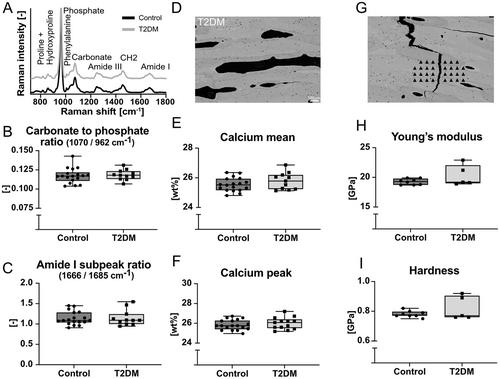When Cortical Bone Matrix Properties Are Indiscernible between Elderly Men with and without Type 2 Diabetes, Fracture Resistance Follows Suit
Eva M. Wölfel, Benjamin Bartsch, Jasmin Koldehoff, Imke A. K. Fiedler, Sofie Dragoun-Kolibova, Felix N. Schmidt, Johannes Krug, Mei-Chun Lin, Klaus Püschel, Benjamin Ondruschka, Elizabeth A. Zimmermann, Hans Jelitto, Gerold Schneider, Bernd Gludovatz, Björn Busse
下载PDF
{"title":"When Cortical Bone Matrix Properties Are Indiscernible between Elderly Men with and without Type 2 Diabetes, Fracture Resistance Follows Suit","authors":"Eva M. Wölfel, Benjamin Bartsch, Jasmin Koldehoff, Imke A. K. Fiedler, Sofie Dragoun-Kolibova, Felix N. Schmidt, Johannes Krug, Mei-Chun Lin, Klaus Püschel, Benjamin Ondruschka, Elizabeth A. Zimmermann, Hans Jelitto, Gerold Schneider, Bernd Gludovatz, Björn Busse","doi":"10.1002/jbm4.10839","DOIUrl":null,"url":null,"abstract":"<p>Type 2 diabetes mellitus (T2DM) is a metabolic disease affecting bone tissue and leading to increased fracture risk in men and women, independent of bone mineral density (BMD). Thus, bone material quality (i.e., properties that contribute to bone toughness but are not attributed to bone mass or quantity) is suggested to contribute to higher fracture risk in diabetic patients and has been shown to be altered. Fracture toughness properties are assumed to decline with aging and age-related disease, while toughness of human T2DM bone is mostly determined from compression testing of trabecular bone. In this case-control study, we determined fracture resistance in T2DM cortical bone tissue from male individuals in combination with a multiscale approach to assess bone material quality indices. All cortical bone samples stem from male nonosteoporotic individuals and show no significant differences in microstructure in both groups, control and T2DM. Bone material quality analyses reveal that both control and T2DM groups exhibit no significant differences in bone matrix composition assessed with Raman spectroscopy, in BMD distribution determined with quantitative back-scattered electron imaging, and in nanoscale local biomechanical properties assessed via nanoindentation. Finally, notched three-point bending tests revealed that the fracture resistance (measured from the total, elastic, and plastic J-integral) does not significantly differ in T2DM and control group, when both groups exhibit no significant differences in bone microstructure and material quality. This supports recent studies suggesting that not all T2DM patients are affected by a higher fracture risk but that individual risk profiles contribute to fracture susceptibility, which should spur further research on improving bone material quality assessment in vivo and identifying risk factors that increase bone fragility in T2DM. © 2023 The Authors. <i>JBMR Plus</i> published by Wiley Periodicals LLC on behalf of American Society for Bone and Mineral Research.</p>","PeriodicalId":14611,"journal":{"name":"JBMR Plus","volume":"7 12","pages":""},"PeriodicalIF":3.4000,"publicationDate":"2023-12-01","publicationTypes":"Journal Article","fieldsOfStudy":null,"isOpenAccess":false,"openAccessPdf":"https://asbmr.onlinelibrary.wiley.com/doi/epdf/10.1002/jbm4.10839","citationCount":"0","resultStr":null,"platform":"Semanticscholar","paperid":null,"PeriodicalName":"JBMR Plus","FirstCategoryId":"1085","ListUrlMain":"https://onlinelibrary.wiley.com/doi/10.1002/jbm4.10839","RegionNum":0,"RegionCategory":null,"ArticlePicture":[],"TitleCN":null,"AbstractTextCN":null,"PMCID":null,"EPubDate":"","PubModel":"","JCR":"Q2","JCRName":"ENDOCRINOLOGY & METABOLISM","Score":null,"Total":0}
引用次数: 0
引用
批量引用
Abstract
Type 2 diabetes mellitus (T2DM) is a metabolic disease affecting bone tissue and leading to increased fracture risk in men and women, independent of bone mineral density (BMD). Thus, bone material quality (i.e., properties that contribute to bone toughness but are not attributed to bone mass or quantity) is suggested to contribute to higher fracture risk in diabetic patients and has been shown to be altered. Fracture toughness properties are assumed to decline with aging and age-related disease, while toughness of human T2DM bone is mostly determined from compression testing of trabecular bone. In this case-control study, we determined fracture resistance in T2DM cortical bone tissue from male individuals in combination with a multiscale approach to assess bone material quality indices. All cortical bone samples stem from male nonosteoporotic individuals and show no significant differences in microstructure in both groups, control and T2DM. Bone material quality analyses reveal that both control and T2DM groups exhibit no significant differences in bone matrix composition assessed with Raman spectroscopy, in BMD distribution determined with quantitative back-scattered electron imaging, and in nanoscale local biomechanical properties assessed via nanoindentation. Finally, notched three-point bending tests revealed that the fracture resistance (measured from the total, elastic, and plastic J-integral) does not significantly differ in T2DM and control group, when both groups exhibit no significant differences in bone microstructure and material quality. This supports recent studies suggesting that not all T2DM patients are affected by a higher fracture risk but that individual risk profiles contribute to fracture susceptibility, which should spur further research on improving bone material quality assessment in vivo and identifying risk factors that increase bone fragility in T2DM. © 2023 The Authors. JBMR Plus published by Wiley Periodicals LLC on behalf of American Society for Bone and Mineral Research.
当患有和未患有 2 型糖尿病的老年男性之间的骨皮质基质特性无法区分时,骨折抵抗力也会随之发生变化
2型糖尿病(T2DM)是一种影响骨组织并导致男性和女性骨折风险增加的代谢性疾病,与骨矿物质密度(BMD)无关。因此,骨材料质量(即有助于骨韧性但不归因于骨量或数量的特性)被认为是糖尿病患者骨折风险较高的因素,并且已被证明是可以改变的。断裂韧性特性被认为随着年龄和年龄相关疾病而下降,而人类T2DM骨的韧性主要通过小梁骨的压缩试验来确定。在这项病例对照研究中,我们测定了男性T2DM皮质骨组织的骨折抵抗性,并结合多尺度方法评估骨材料质量指标。所有皮质骨样本均来自男性非骨质疏松症患者,两组、对照组和T2DM患者的微结构无显著差异。骨材料质量分析显示,对照组和T2DM组在拉曼光谱评估的骨基质组成、定量背散射电子成像确定的骨密度分布以及纳米压痕评估的纳米尺度局部生物力学性能方面均无显著差异。最后,缺口三点弯曲试验显示,当两组在骨微观结构和材料质量上没有显着差异时,T2DM组和对照组的断裂抗力(从总、弹性和塑性J积分测量)没有显着差异。这支持了最近的研究表明,并非所有T2DM患者都有较高的骨折风险,但个体风险概况有助于骨折易感性,这应该促进进一步研究,以改善体内骨材料质量评估,并确定增加T2DM患者骨易碎性的危险因素。©2023作者。JBMR Plus由Wiley期刊有限责任公司代表美国骨骼和矿物研究协会出版。
本文章由计算机程序翻译,如有差异,请以英文原文为准。



